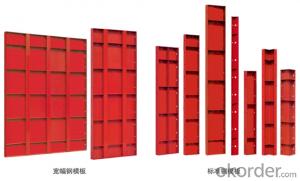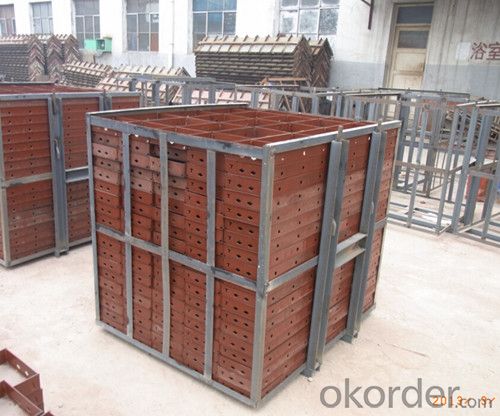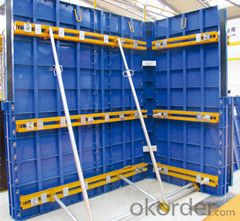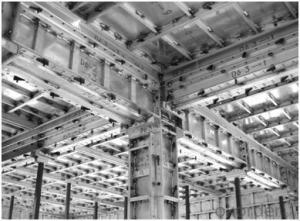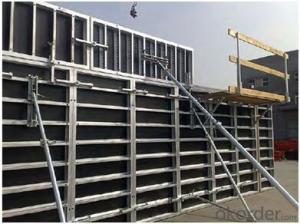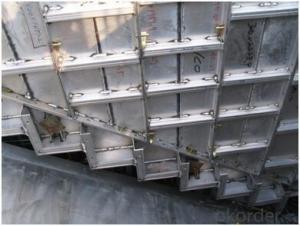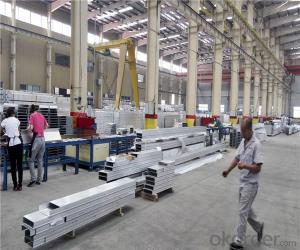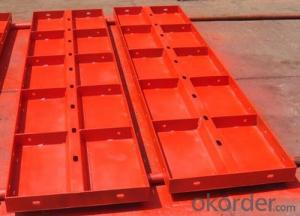Wholly Steel Formwork for Wall & Column with Customized Design
- Loading Port:
- China main port
- Payment Terms:
- TT OR LC
- Min Order Qty:
- 500 pc
- Supply Capability:
- 100000 pc/month
OKorder Service Pledge
OKorder Financial Service
You Might Also Like
Introduction for Steel Formwork :
Steel Formwork:used in highway,railway,bridge,tunnel and shearing wall,etc.Our company CNBM which is one of the largest State-Owned Enterprises in China which established in 1984 , has gained the confirmation from the specialist of China Architecture Scence Institute, and has been used by many building operation units and has been highly praised.In 2014, the total turnover volume of CNBM exceeds US$410 billion dollars with a total staff of 180,000. CNBM is listed in the World Top 500 Enterprises !
Characteristic for Wholly Steel Formwork :
1. High Smooth Surface
2. Convex ling for Edge Rib
3. Specialized Connection Pin for Edge Rib Connection
4. High Stiffness for Steel Surface
5. Light Weight for saving producing cost
6. Fast Separate and Easy transport
7. Recycling using
8. Scientific and Reasonable design to meet different working condition
Parameter and Specification :
Code | Size (mm) | Weight (KG) | Code | Size (mm) | Weight (KG) |
P12021 | 1200*2100*55 | 102.96 | P4018 | 400*1800*55 | 28.3 |
P12018 | 1200*1800*55 | 88.4 | P4015 | 400*1500*55 | 23.8 |
P12015 | 1200*1500*55 | 74.15 | P4012 | 400*1200*55 | 19.1 |
P12012 | 1200*1200*55 | 60.11 | P4009 | 400*900*55 | 14.6 |
P10018 | 1000*1800*55 | 76.01 | P4007 | 400*750*55 | 12.3 |
P10015 | 1000*1500*55 | 63.96 | P4006 | 400*600*55 | 9.95 |
P10012 | 1000*1200*55 | 60.11 | P3018 | 300*1800*55 | 20.7 |
P10009 | 1000*900*55 | 39.32 | P3015 | 300*1500*55 | 17.4 |
P9018 | 900*1800*55 | 70.89 | P3012 | 300*1200*55 | 14 |
P9015 | 900*1500*55 | 59.47 | P3009 | 300*900*55 | 10.7 |
P9012 | 900*1200*55 | 48.03 | P3007 | 300*750*55 | 8.8 |
P7518 | 750*1800*55 | 57.8 | P3006 | 300*600*55 | 7.3 |
P7515 | 750*1500*55 | 48.47 | P3004 | 300*400*55 | 5.46 |
P7512 | 750*1200*55 | 39.16 | P2515 | 250*1500*55 | 15.17 |
P7509 | 750*900*55 | 29.85 | P2512 | 250*1200*55 | 12.24 |
P7507 | 750*750*55 | 24.81 | P2509 | 250*900*55 | 9.32 |
P6018 | 600*1800*55 | 43.1 | P2507 | 250*750*55 | 7.71 |
P6015 | 600*1500*55 | 36.3 | P2506 | 250*600*55 | 6.39 |
P6012 | 600*1200*55 | 31.7 | P2015 | 200*1500*55 | 11.6 |
P6009 | 600*900*55 | 23.9 | P2012 | 200*1200*55 | 9.4 |
P6007 | 600*750*55 | 18.55 | P2009 | 200*900*55 | 7.1 |
P6006 | 600*600*55 | 16.25 | P2007 | 200*750*55 | 5.9 |
P5018 | 500*1800*55 | 36.27 | P2006 | 200*600*55 | 6.39 |
P5015 | 500*1500*55 | 30.15 | P2004 | 200*450*55 | 3.64 |
P5012 | 500*1200*55 | 25.55 | P1515 | 150*1500*55 | 9.5 |
P5009 | 500*900*55 | 20.38 | P1506 | 150*600*55 | 4 |
P5007 | 500*750*55 | 15.48 | P1504 | 150*450*55 | 2.98 |
P5006 | 500*600*55 | 13.58 | P1015 | 100*1500*55 | 7.5 |
Code | Size (mm) | Weight (KG) |
P1012 | 100*1200*55 | 6.9 |
P1009 | 100*900*55 | 4.6 |
P1007 | 100*750*55 | 3.8 |
P1006 | 100*600*55 | 3.1 |
P1004 | 100*450*55 | 2.33 |
E1515 | 150*150*1500 | 15.2 |
E1512 | 150*150*1200 | 12.26 |
E1509 | 150*150*900 | 9.34 |
E1507 | 150*150*750 | 7.77 |
E1506 | 150*150*600 | 6.46 |
E1504 | 150*150*450 | 4.87 |
E1015 | 100*150*1500 | 13.13 |
E1012 | 100*150*1200 | 10.61 |
E1009 | 100*150*900 | 8.07 |
E1006 | 100*150*600 | 5.44 |
Y1018 | 100*150*1800 | 14.56 |
Y1015 | 100*150*1500 | 12.29 |
Y1012 | 100*150*1200 | 9.72 |
Y1009 | 100*150*900 | 7.46 |
Y1007 | 100*150*700 | 6.19 |
Y1006 | 100*150*600 | 5.19 |
Y1004 | 100*150*450 | 3.92 |
J0018 | 50*50*1800 | 4.34 |
J0015 | 50*50*1500 | 3.7 |
J0012 | 50*50*1200 | 2.94 |
J0009 | 50*50*900 | 2.3 |
J0007 | 50*50*750 | 1.9 |
J0006 | 50*50*600 | 1.5 |
J0004 | 50*50*450 | 1.13 |
FAQ :
1. Who are we ?
We , CNBM , are a State-Owned Enterprise which established in 1984 , have 32 years experience ,enjoy high reputation .
2. Our Advantage :
Customized products , we have our own R&D department , we can design the drawing and suggest the suitable solution for your project .
3. Our after-Sales Service :
The international Sales Manager and Engineer can go to your job site for work direction and help you deal with your project .
Factory Photos :
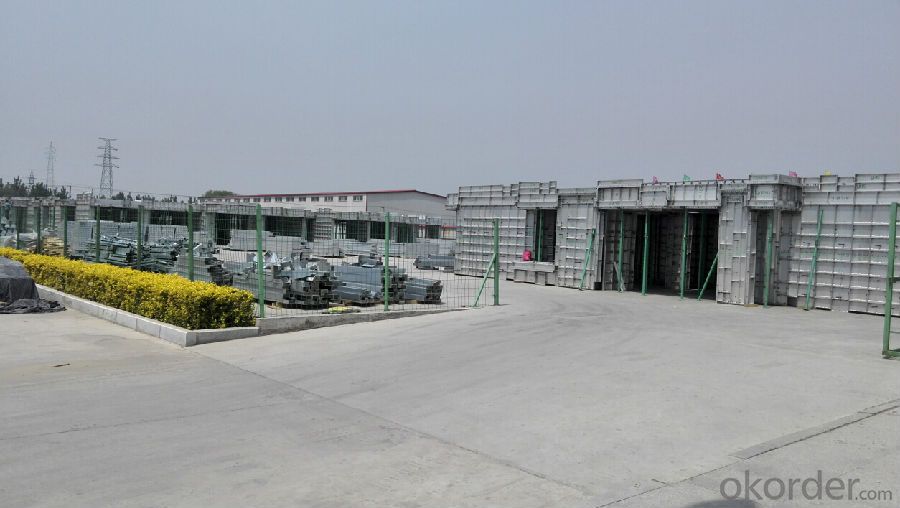
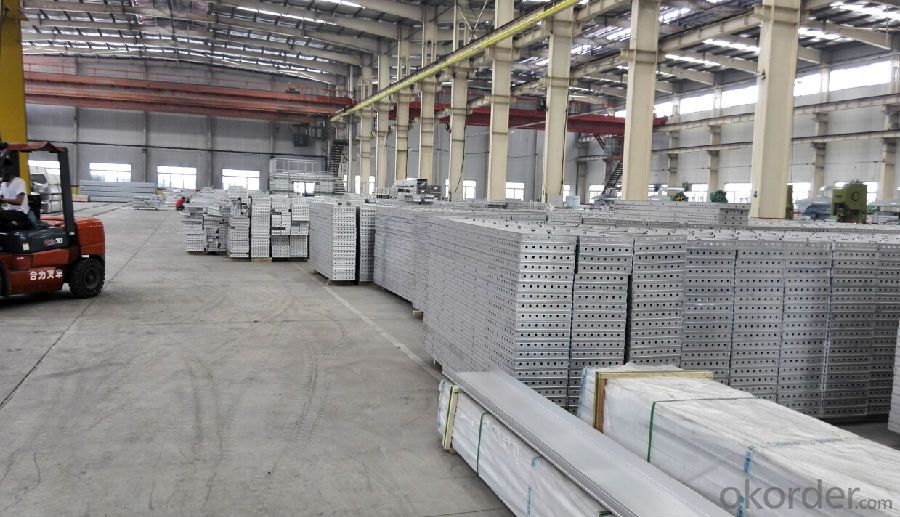
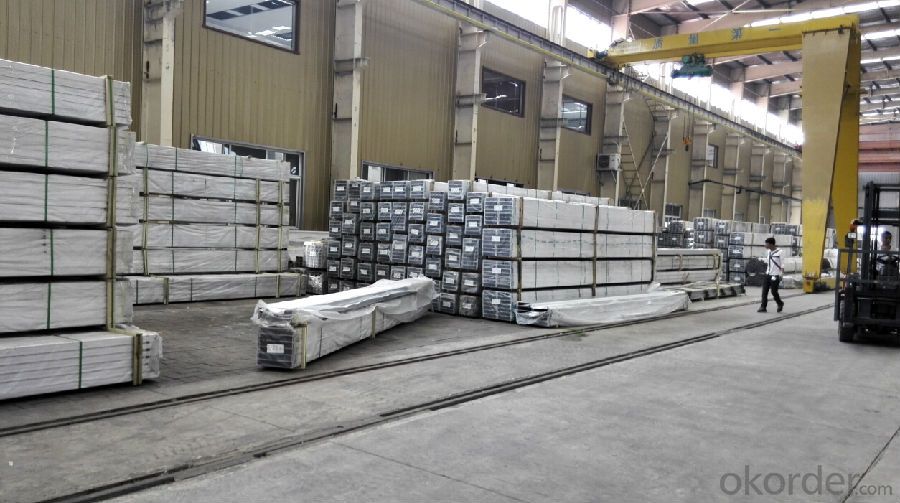
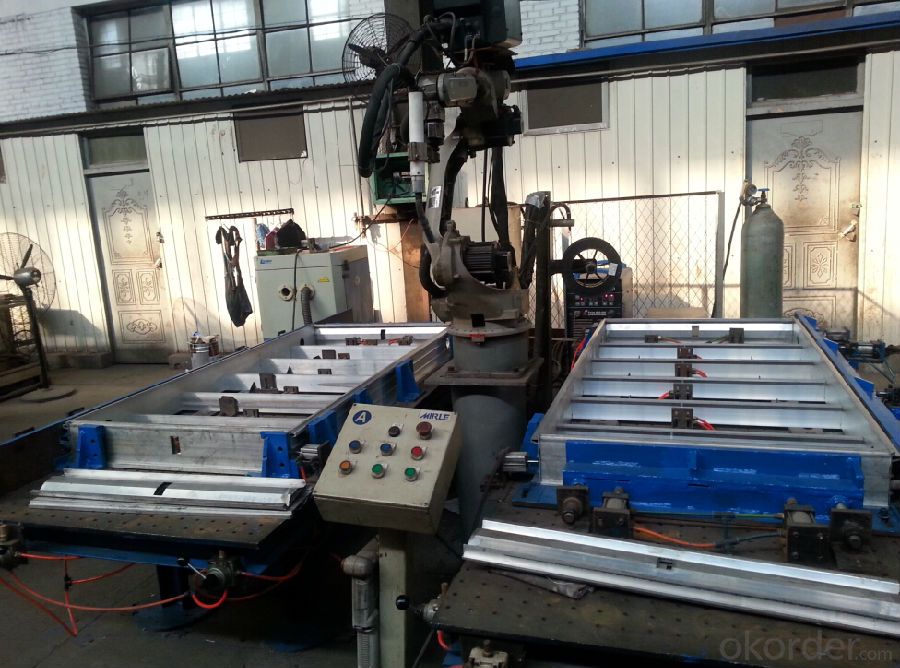
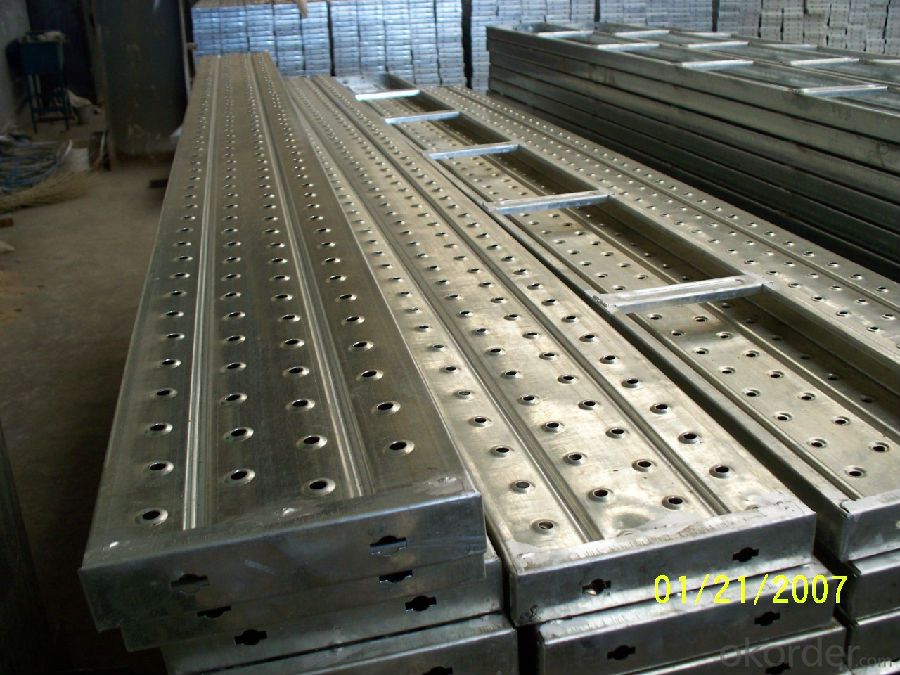
- Q: How does steel formwork affect the overall quality control of a construction project?
- Steel formwork can have a significant impact on the overall quality control of a construction project. Firstly, steel formwork provides a higher level of precision and accuracy compared to other types of formwork materials such as wood or plastic. This enables construction teams to achieve more precise dimensions and shapes, resulting in a higher quality finished product. Additionally, steel formwork offers better durability and stability, which reduces the risk of deformations or damages during the concrete pouring process. This ensures that the final structure maintains its integrity and structural stability over time. The use of steel formwork also minimizes the occurrence of surface imperfections, such as cracks or unevenness, which can significantly affect the aesthetic appearance and overall quality of the construction project. Furthermore, steel formwork allows for faster construction cycles, as it is reusable and can be easily assembled and dismantled. This not only saves time but also helps to maintain consistency in the construction process, leading to improved quality control. The ability to reuse steel formwork also reduces waste and environmental impact, promoting sustainable construction practices. Another important aspect of steel formwork is its ability to withstand high pressures and loads, making it suitable for constructing complex structures and high-rise buildings. This strength and stability contribute to the overall safety and resilience of the construction project, further enhancing its quality control. In conclusion, steel formwork positively affects the overall quality control of a construction project by offering precision, durability, stability, speed, and safety. Its use ensures that the construction project meets the desired standards, resulting in a high-quality final product that meets both functional and aesthetic requirements.
- Q: Can steel formwork be easily transported to different job sites?
- Yes, steel formwork can be easily transported to different job sites. Steel formwork is known for its durability and strength, making it suitable for repeated use and easy transportation. It can be disassembled and reassembled without losing its structural integrity, allowing it to be easily transported to different locations. Additionally, steel formwork is lightweight compared to other types of formwork, making it easier to handle and transport using regular construction machinery or vehicles. Its versatility and transportability make steel formwork a popular choice for construction projects that require frequent movement between job sites.
- Q: Are there any specific maintenance requirements for steel formwork?
- Yes, steel formwork requires regular maintenance to ensure its durability and optimal performance. Some specific maintenance requirements for steel formwork include cleaning, removing concrete residue, inspecting for any signs of damage or corrosion, and applying protective coatings to prevent rust. Additionally, proper storage and handling practices should be followed to prevent any deformation or bending of the steel formwork components.
- Q: How does steel formwork handle different concrete early age strength development?
- Steel formwork is a versatile and durable option for handling different concrete early age strength development. Due to its strength and rigidity, steel formwork provides excellent support during the initial stages of concrete curing. It can withstand the high pressures exerted by fresh concrete, ensuring that the formwork remains intact and stable during the early age strength development. Additionally, steel formwork allows for efficient and precise placement of concrete, enabling proper consolidation and uniform curing. Overall, steel formwork is a reliable choice that can effectively handle the varying early age strength development of concrete.
- Q: How does steel formwork contribute to the overall aesthetics of a structure?
- Steel formwork can contribute to the overall aesthetics of a structure by providing a smooth and clean finish to concrete surfaces. Its rigid and durable nature allows for precise shaping and detailing, resulting in sharp edges and smooth surfaces that enhance the visual appeal of a building. Additionally, steel formwork offers flexibility in design, enabling architects to create complex and unique shapes, adding an artistic touch to the structure.
- Q: How does steel formwork handle different concrete finishing techniques?
- Steel formwork is very versatile and can handle various concrete finishing techniques with ease. Its sturdy and rigid structure allows for smooth and precise concrete finishes, regardless of the technique used. Steel formwork ensures that the concrete is held securely in place during the pouring and setting process, allowing for intricate detailing and precise shaping. Whether it's a smooth finish, textured patterns, or decorative imprints, steel formwork provides the necessary support and stability to achieve the desired concrete finishing technique effectively.
- Q: How much weight can steel formwork support?
- The weight that steel formwork can support depends on various factors such as the size and thickness of the steel, the design of the formwork, and the supporting structure. Generally, steel formwork is capable of supporting heavy loads ranging from a few hundred kilograms to several tonnes.
- Q: How does steel formwork affect the construction schedule?
- The construction schedule can be significantly impacted by steel formwork. One of the main benefits of using steel formwork is its ability to provide a high level of stability and strength, enabling faster construction processes. This results in reduced overall construction time compared to traditional formwork methods. Moreover, steel formwork is highly durable and can be used multiple times, making it suitable for future projects. This reduces the time and cost associated with acquiring and assembling new formwork for each project, further enhancing the efficiency of the construction schedule. In addition, steel formwork allows for precise and accurate construction, resulting in a higher quality finished product. This minimizes the need for rework and corrections, ultimately saving time and ensuring that the project stays on schedule. Furthermore, steel formwork is known for its flexibility and adaptability. It can be easily adjusted and modified to accommodate design or construction changes. This promotes a smoother workflow and minimizes delays that may arise from design alterations. However, it is important to note that the initial setup and installation of steel formwork may require more time and resources compared to other formwork systems. The design and fabrication process for steel formwork can be more complex, necessitating careful planning and coordination. Therefore, it is crucial to consider these factors during the project planning phase to ensure that the construction schedule is not negatively affected. Overall, steel formwork can significantly expedite the construction schedule by offering strength, durability, precision, and adaptability. However, it is essential to thoroughly evaluate project requirements and available resources to optimize the use of steel formwork and minimize potential disruptions to the construction schedule.
- Q: How does steel formwork accommodate for different concrete pouring methods?
- Steel formwork is highly versatile and can easily accommodate different concrete pouring methods. Its modular design allows for easy adjustment and reconfiguration to match the specific requirements of each pouring method. For instance, when using the traditional method of pouring concrete, the steel formwork can be assembled and secured in place to create a sturdy mold for the concrete. Alternatively, when employing the slip forming method, the steel formwork can be continuously moved upward as the concrete is poured, ensuring a seamless and uniform construction process. Overall, steel formwork provides the flexibility and adaptability needed to accommodate various concrete pouring methods effectively.
- Q: How does steel formwork handle different concrete surface repair techniques?
- Steel formwork is a versatile and durable option for handling different concrete surface repair techniques. One of the key advantages of steel formwork is its ability to withstand the pressures and stresses associated with concrete repairs. When it comes to techniques such as patching or resurfacing, steel formwork provides a strong and stable framework to contain the concrete mixture. It can withstand the weight of the repair materials and the pressure exerted by the concrete as it sets and cures. This ensures that the repair is properly contained and that the desired shape and dimensions are achieved. Steel formwork also offers flexibility in terms of shape and design. It can be easily customized to accommodate different repair requirements, whether it involves straight surfaces, curves, or complex geometries. The strength of steel allows for the creation of intricate formwork structures that can handle even the most challenging repair projects. Moreover, steel formwork provides excellent reusability and durability. It can be used repeatedly without significant wear and tear, making it a cost-effective solution for multiple repair projects. This durability ensures that the formwork remains intact throughout the repair process, maintaining the integrity of the repair and preventing any potential issues. Furthermore, steel formwork is resistant to moisture and chemicals, which are often present in concrete repairs. This resistance ensures that the formwork remains in good condition and does not corrode or deteriorate when in contact with the repair materials. This is particularly important for long-term repairs where the formwork may be in place for an extended period. In conclusion, steel formwork is a reliable and effective option for handling different concrete surface repair techniques. Its strength, flexibility, reusability, and resistance to moisture and chemicals make it an ideal choice for containing and shaping the repair materials, ensuring a successful and durable repair.
Send your message to us
Wholly Steel Formwork for Wall & Column with Customized Design
- Loading Port:
- China main port
- Payment Terms:
- TT OR LC
- Min Order Qty:
- 500 pc
- Supply Capability:
- 100000 pc/month
OKorder Service Pledge
OKorder Financial Service
Similar products
Hot products
Hot Searches
Related keywords
